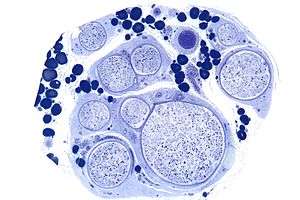Neuropathology

Neuropathology is the study of disease of nervous system tissue, usually in the form of either small surgical biopsies or whole-body autopsies. Neuropathology is a subspecialty of anatomic pathology, neurology, and neurosurgery. It should not be confused with neuropathy, which refers to disorders of the nerves themselves (usually in the peripheral nervous system).
Methodology
The work of the neuropathologist consists largely of examining biopsy tissue from the brain and spinal cord to aid in diagnosis of disease. The biopsy is usually requested after a mass is detected by radiologic imaging. As for autopsies, the principal work of the neuropathologist is to help in the post-mortem diagnosis of various forms of dementia and other conditions that affect the central nervous system.
Biopsies can also consist of the skin. Epidermal nerve fiber density testing (ENFD) is a more recently developed neuropathology test in which a punch skin biopsy is taken to identify small fiber neuropathies by analyzing the nerve fibers of the skin. This pathology test is becoming available in select labs as well as many universities; it replaces the traditional sural nerve biopsy test as less invasive. It is used to identify painful small fiber neuropathies.
Focus of specialization
In many English speaking countries neuropathology is considered a subfield of anatomical pathology. In contrast, there are a number of independent university chairs in neuropathology and even institutes of neuropathology in German speaking countries due to a different historical background. A physician who specializes in neuropathology, usually by completing a fellowship after a residency in anatomical or general pathology, is called a neuropathologist. In day-to-day clinical practice, a neuropathologist is a consultant for other physicians. If a disease of the nervous system is suspected, and the diagnosis cannot be made by less invasive methods, a biopsy of nervous tissue is taken and sent to the neuropathologist, who examines it using a microscope or certain molecular methods to make a definitive diagnosis.
Many neuropathologists in Europe have a background in the clinical neurosciences (neurology, psychiatry) as well as pathology.
Neuropathology in the US System
Neuropathologists are physicians with MD (Doctor of Medicine) degrees. They must finish either 2 or 3 years of an anatomical pathology residency followed by 2 years of a neuropathology fellowship and be certified by the American Board of Pathology[1] in both anatomical and neuropathology. This is less specialized neuropathology training than in most other countries. It is also quite common for neuropathologists to have a Ph.D. in a related field.
Neuropathology in the UK/Canadian/Commonwealth System
Neuropathologists are medically qualified practitioners who are registered with the General Medical Council in the UK. A postgraduate qualification in neuropathology is obtained through training and an examination overseen by the Royal College of Pathologists UK. A neuropathologist has training in anatomic pathology followed by training in relation to diagnosis of diseases of the nervous system and muscle. The training in other European and commonwealth countries is similar. In Canada, Neuropathologists complete a 5-year Royal College of Physicians and Surgeons of Canada Neuropathology residency including a year of clinical medicine and a year of anatomical pathology. It is quite common for neuropathologists to have PhDs in a related field.
In addition to examining central nervous system tissue, the neuropathologist usually is assigned the task of examining muscle and peripheral nerve biopsies. Muscle biopsies are taken to aid in the diagnosis of muscle diseases (such as polymyositis, mitochondrial myopathy, etc.). Peripheral nerve is assessed to help work up patients with suspected peripheral neuropathies secondary to such conditions as vasculitis and amyloidosis.
Neuropathology is a heavily research-oriented field.
Prominent historical and current figures in neuropathology
Santiago Ramon y Cajal is considered one of the founders of modern neuroanatomy. Alois Alzheimer, the person after whom Alzheimer's disease is named, is considered an important early contributor to the field.
There are many neuropathologists around the world who have made important clinical and research contributions toward our understanding of diseases that specifically affect the brain (degenerative diseases, multiple sclerosis, stroke, brain tumors, trauma and neuromuscular diseases). The majority are members of the International Society of Neuropathology (ISN). For neuropathologists practicing within the United States of America please refer to the Membership Directory available through the American Association of Neuropathologists (AANP) website. There are also Membership Directories available for many of the neuropathology societies that exist in other specific countries and/or regions of the world (British, European, Canadian... etc.).
Progress
A European Board Examination in Neuropathology which emphasizes the importance of proper training in the neurosciences is currently being established (www.euro-cns.org). The most recent international meeting of neuropathologists occurred in September 2014 in Rio de Janeiro, Brazil.
Neuropathology journals
Academic neuropathology is served by several specialist neuropathology journals. Acta Neuropathologica is the neuropathology journal with the highest impact factor.[2] Some journals are sponsored by national or international neuropathology associations: Brain Pathology is the official journal of the International Society of Neuropathology, Neuropathology & Applied Neurobiology is sponsored by the British Neuropathological Society, the Journal of Neuropathology & Experimental Neurology is the official journal of the American Association of Neuropathologists (AANP) and "Neuropathology" is the official journal of the Japanese Society of Neuropathology.
Further reading
Neuropathology and iron, in Hider, Robert C.; Kong, Xiaole (2013). "Chapter 8. Iron: Effect of Overload and Deficiency". In Astrid Sigel, Helmut Sigel and Roland K. O. Sigel. Interrelations between Essential Metal Ions and Human Diseases. Metal Ions in Life Sciences. 13. Springer. pp. 229–294. doi:10.1007/978-94-007-7500-8_8.
References
External links
- American Association of Neuropathologists
- British Neuropathological Society
- EuroCNS European Conferderation of Neuropathological Societies
- International Society of Neuropathology
- Blog by neuropathologist Brian E. Moore, MD
- Web site by Dimitri Agamanolis, M.D.
